River is resurrected
The long-dry Owens now teems with birds and fish.
Source of this article – Los Angeles Times, July 8, 2007.

River ecologist Mark Hill propels himself down the Lower Owens River aboard a 16-foot inflatable kayak.
Independence, Calif. — Healing ailing rivers is Mark Hill’s specialty. So when the tall and lean ecologist visits one of his works in progress, he’s prepared to paddle a long and sinuous route to assess the health of his watery patient.
In this case, his charge is the Lower Owens River, a 62-mile-long stretch left essentially dry in 1913 after its flows of Sierra snowmelt were diverted into the Los Angeles Aqueduct. After decades of political bickering, water was directed back into the riverbed in December, launching the largest river restoration effort ever attempted in the West.
Ecologists knew the Lower Owens would come back to life. But how fast would it rebuild itself? Which wildlife would appear first? Which plants?
Scientists have been surprised by some of the early answers, and to flesh out the details Hill recently took his first survey by kayak of the river. Hill, the lead scientist in the Lower Owens River Project, stepped into a blue inflatable 16-foot kayak, said “Let’s go,” and was soon scooting through the channel that cuts across the Owens Valley.
Hill’s daylong journey, which included visitors in a separate kayak, was marked by striking displays of birds, fish and insects already setting up shop during the restored river’s first summer. The water ran cold and, in this part of the channel, about knee deep. But the water was so clear that it seemed as though the kayaks were moving barely above the gravel bottom.
Locals call this vast, arid region, about 200 miles north of Los Angeles, “The Big Quiet.” It’s easy to see why. The only sounds were the slosh of waves along the hulls, the dip of paddle blades and the occasional melodic konk-la-ree of red-winged blackbirds nesting in bulrushes.
“Wow! Look at that,” Hill said, nodding toward a cloud of baby largemouth bass — evidence of the species’ first spawn in the revived river system — wafting through a tangle of water lilies. Nearby, carp and Owens River suckers, some of them more than a foot long, grazed amid submerged pastures of moss that, in turn, fed on nutrients in the channel that for decades “had more cow poop than water in it,” Hill said.
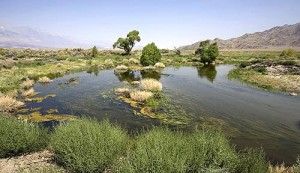
Just north of the town of Independence and looking north toward Bishop, the Lower Owens River has burst to life in the months since the L.A. Department of Water and Power began allowing water back into the channel. Among the flora aided by the river restoration effort are sagebrush and willow trees.
Great blue herons and kingfishers plucked fish from myriad shallow inlets created by the new flows. At dusk, bank swallows caught flying insects after emerging from small caves they had chipped out of steep riverbank cliffs.
The water, which comes from the Upper Owens River, began its journey high in the Sierra Nevada. Most water from the Upper Owens continues to pour into the Los Angeles Aqueduct, but some now heads into the Lower Owens and travels 62 miles to Owens Lake, which was left dry after the aqueduct opened in 1913.
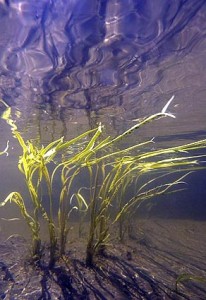
Restoration experts have been surprised by the clarity of the water in the restored river. Bulrush plants like these are thriving again.
The original river channel here was formed about 25,000 to 50,000 years ago, during the Pleistocene Epoch, and the water flowed in torrents as fast as 3,000 cubic feet per second. The water now courses at a carefully controlled rate of about 40 cubic feet per second.
That rate is about the pace of a leisurely stroll, and when the diversion project began Dec. 6, it took about 19 days for the water to arrive at the northern end of Owens Lake. When the water reaches the lake, it is pumped back into the aqueduct to head for Los Angeles. (It appeared that no water was taken from the river to fight fires that started Friday in the Inyo National Forest.)
The Lower Owens River can’t be called pristine. For nearly a century, the riverbed was trampled by cattle, overgrown with invasive plants and trees and mostly dry, save for a few spring-fed ponds. Paradoxically, these conditions provide benefits that will help in the channel’s recovery.
The manure-fed moss provides food for unexpectedly vigorous populations of fish, which have begun venturing out beyond the spring-fed ponds. Gravel in the riverbed provides an ideal habitat for diatoms, beautiful microscopic algae and early links in the food chain.
Tree stumps, eyesores when the channel was dry, now offer shelter for young fish or redirect currents, which sometimes gouge the riverbed. Mathematical simulations predicted the water would run about 2 to 4 feet deep, depending on the width of the channel. But the redirected currents are digging out sections 6 to 10 feet deep in places.
“We didn’t expect to see this much velocity in the river,” Hill said. “We didn’t expect to see this much clarity in the river. We didn’t expect to see this many deep holes in the river.”
Groundwater has recharged and risen faster than anticipated and oxygen levels remain high, creating hundreds of channels and ponds that will soon become ideal habitat for waterfowl and fish. “All good signs the river is coming on strong,” Hill said.

The Lower Owens River was essentially left dry when water diversions into the Los Angeles Aqueduct began in 1913, but now the 62-mile channel is returning to life. This view looks north, with the Inyo Mountains in the background.
Later this year, the Los Angeles Department of Water and Power plans to release pulses of water at rates of 200 cubic feet per second to mimic annual flood cycles and distribute willow seeds. If all goes according to plan, within a decade, willows will cloak the banks, creating shady canopies over pools that Hill predicted would be “prime bass and catfish real estate.”
But the arrival of some species means the departure of others. When willows and cottonwoods finally shade parts of the river, sun-hungry moss will disappear from those areas. Some desert shrubs, such as salt brush, rabbit brush and bitter weed, are already dying because they don’t like the high water table.
“We’re witnessing the start of a recovery that will occur in stages in what has become an enormous outdoor laboratory for river restoration,” Hill said.
The project was long in coming and, like most issues involving water between Los Angeles and the Owens Valley, a source of irritation. In a place where residents like to say “Los Angeles stole our water fair and square,” tensions between the DWP and environmentalists and local communities continue to flare.
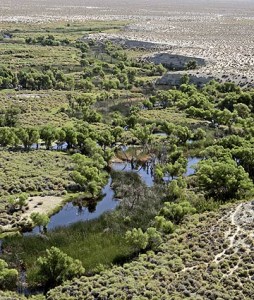
The canopy formed by these willows just north of Lone Pine is a model for what’s expected elsewhere along the river.
Earlier this year, a judge said the DWP had not done all that was required in the Lower Owens River Project. As a result, Inyo County Superior Court Judge Lee E. Cooper denied a request by the city to lift fines of $5,000 a day that the judge imposed Sept. 5, 2005, for failing to restore the river in a timely manner.
These days, the river’s flow and nature’s rapid response are instilling a new sense of pride at the DWP, long viewed as a hostile landlord and responsible for environmental devastation. For locals, the project is a remarkable gift of conservation and potential boon for the tourist stops along U.S. 395 just east of the snaggletoothed Sierra range.
Francis Pedneau, a lifelong rockhound and bass fisherman in these parts, described the improved relations with Los Angeles this way: “I have a big bias against the DWP, but they’ve been so cooperative with us fishermen lately that it makes us wonder what they’ve got up their sleeves.”
During a recent flight over the Lower Owens, pilot and local motel owner Martin Powell banked his single-engine Cessna over glistening marshlands north of the community of Lone Pine and said, “It’s as green as I’ve ever seen it. There’s a lot of sand down there seeing water for the first time outside of a rainstorm. Very nice. Very nice.”
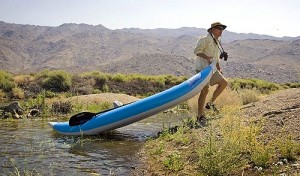
Hill pulls his inflatable kayak out of the water to take a closer look at the new growth that has sprouted in the area since water was redirected into the riverbed..
Back in the river channel, Hill maneuvered his kayak among clumps of tumbleweeds, tree stumps, beaver dams and tule thickets, which are a continuing problem because they obstruct ideal flow patterns.
The DWP is considering using a special machine to remove tules, Hill said.
But the project’s biggest challenge, he said, will be keeping the valley’s cattle herds away from pioneer colonies of willows and cottonwoods until they can grow to a height of at least 4 to 6 feet.
“We’re putting up more than 50 miles of barbed-wire fences along the river channel to manage the cows,” Hill said. “To cows, willow shoots are like candy.”
Most of the restoration work, then, falls to Mother Nature. There are no plans to stock the stream with fish or new plants. In about five to seven years the larger species in the food chain, such as elk, deer and mountain lion, will establish themselves along the river system.
For now, that system continues to awaken. The kayaks slipped past willows spewing seeds into the flow. Brambles buzzed with dragonflies that were dropping eggs into the water, which will produce larvae to feed fish. A green tree frog climbed aboard a patch of bunch grass.

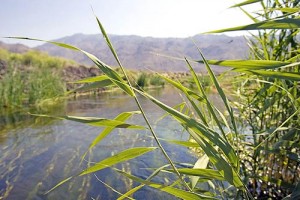



0 Comments